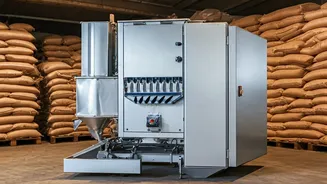Automated Grain Dispensing
Grain ATMs, or automated teller machines, represent a significant advancement in food distribution systems. They provide a convenient and efficient way
for people to access essential grains. This technology is designed to dispense grains like rice, wheat, and other staples in pre-measured quantities, much like a regular ATM dispenses cash. The process is relatively straightforward, allowing beneficiaries to insert their ration cards, select the required grain, and receive it directly from the machine. This automation streamlines the process, reducing manual labor and the potential for human error. It also helps to eliminate common issues such as delays or shortages in distribution. The machines are typically strategically placed in areas with high population density or where access to ration shops is limited, thereby increasing accessibility for vulnerable communities. The implementation of grain ATMs marks a step toward more inclusive and efficient food security programs in the region.
Enhancing Accessibility
One of the primary benefits of Gujarat's grain ATMs is the enhanced accessibility they provide, particularly for those with limited mobility or residing far from distribution centers. These ATMs are strategically positioned in locations that are easily accessible to the target population. This means individuals no longer need to travel long distances or spend excessive time waiting in queues to obtain their monthly rations. The automated system operates efficiently, ensuring the availability of grains at all times, thereby reducing the stress associated with food procurement. This is particularly beneficial for the elderly, disabled, and women, who often face challenges accessing traditional ration shops. Furthermore, the accessibility extends beyond physical convenience, as the machines usually offer multilingual interfaces, enabling better understanding and easier use by a diverse population. By improving access to essential grains, these ATMs contribute substantially to the well-being of the communities they serve.
Reducing Wastage & Pilferage
Grain ATMs play a crucial role in curbing wastage and preventing pilferage within the food distribution network. Traditional methods of grain distribution often lead to losses due to spillage, improper storage, and potential corruption. These automated machines significantly minimize these risks. Precise dispensing mechanisms in the ATMs measure the grain accurately, ensuring that each beneficiary receives the exact amount they are entitled to. This minimizes wastage during the dispensing process. Furthermore, the secure design of these machines helps to prevent unauthorized access and theft of grains. By reducing wastage and pilferage, grain ATMs optimize the use of resources and guarantee that the maximum amount of food reaches the intended recipients. This also leads to better cost management and resource allocation within the food security program, as it reduces the need to account for significant losses of grains during distribution. In essence, these automated systems streamline operations and ensure that food resources are used in the most efficient manner.
Impact on Food Security
The implementation of grain ATMs has significantly impacted food security in Gujarat. By ensuring that grains are readily available and accessible, these machines contribute to the reduction of hunger and malnutrition in vulnerable communities. The efficiency and reliability of the ATMs guarantee a consistent supply of food, thereby improving the overall stability of the food supply chain. Beneficiaries have greater control over when and how they receive their rations, reducing dependence on distribution schedules. This promotes self-sufficiency and improves nutritional outcomes within the population. Moreover, the transparent nature of the system promotes accountability. The records of each transaction are easily accessible, making it easier to monitor and evaluate the efficiency and effectiveness of the food distribution program. Overall, grain ATMs enhance food security, ensuring that essential resources are accessible to those who need them most.
Challenges & Considerations
While grain ATMs have brought many advantages, certain challenges and considerations are important for their effective operation. One major issue is the requirement for regular maintenance and upkeep of the machines, to ensure they remain functional and reliable. This includes addressing any technical issues promptly and establishing a consistent supply of electricity. Furthermore, ensuring that all beneficiaries possess the necessary documents, such as ration cards, is vital for seamless access. The initial cost of installing these machines can also be significant. However, considering the long-term benefits in reducing wastage and improving efficiency, the investment can be viewed as a worthwhile expense. Additionally, regular training of the operators and beneficiaries on how to use the machines is essential to overcome any initial hesitations or challenges. Addressing these challenges through effective planning and proactive measures can significantly improve the efficacy of grain ATMs in supporting food security.












